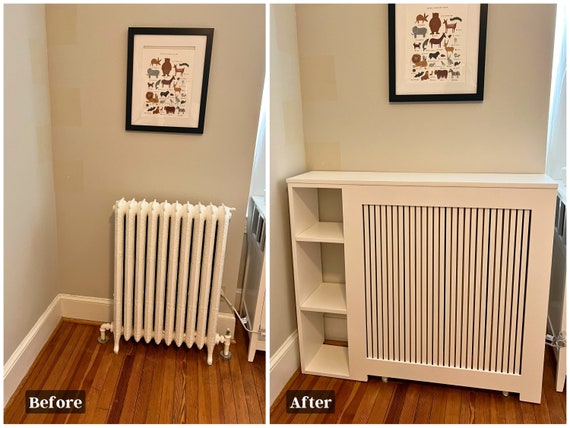What Does Modern Radiator Covers Do?
What Does Modern Radiator Covers Do?
Blog Article
Modern Radiator Covers Fundamentals Explained
Table of ContentsThe Definitive Guide for Modern Radiator CoversWhat Does Modern Radiator Covers Do?The smart Trick of Modern Radiator Covers That Nobody is Talking AboutUnknown Facts About Modern Radiator CoversModern Radiator Covers - The Facts
For home owners that think their radiators are eye sores, a radiator cover is a great means to hide them. Do radiator covers block the heat?The relationship in between radiator covers and warmth circulation is more nuanced than lots of could anticipate. Prior to reviewing radiator covers, let's comprehend exactly how the home heating device functions. Your home's radiator functions by transferring warmth from warm water, or heavy steam, to the area around it via the principles of convection and radiation.
When warm water circulates via it, the steel surface area absorbs the warm. When this heated liquid is flowed through your system right into the radiator, its steel surface takes in the warmth from the warm water. As the surrounding air warms, it comes to be less thick and increases, developing a convection current that flows warm air throughout the area.
Not known Details About Modern Radiator Covers
There are techniques to improve this convection current and make your radiator a lot more effective. These enhancements consist of: Placing your radiator under a window counteracts cool air going into the space and boosts warmth blood circulation. Modern radiators have convectors (fins or panels) that boost the area, boosting warm transfer.: Positioning an aluminum foil sheet or panel behind the radiator stops warm loss into the wall and directs extra warmth into the space.
Radiation plays a much smaller sized duty in home heating compared to convection. It transfers warm via electromagnetic waves, comparable to how the sunlight warms your skin. Radiation also does not call for any tool to transfer heat, which is how the sunlight can warm your face. While this process does add to heat, its influence on a radiator's performance is minimal contrasted to convection.

With radiator covers providing security and tranquility of mind, it is perhaps the most important reason to mount one in the home. A properly designed radiator cover can develop extra shelf area.
How Modern Radiator Covers can Save You Time, Stress, and Money.
With the appropriate radiator cover, you can hide unappealing radiators and allow them to mix right into the area's visual. When it comes to radiator covers impacting heat output, there are numerous variables to think about, which include the following: The materials made use of to develop a radiator cover matter.
Various other materials, like wood, heat insulation, and fabrics, will take in and lower your radiator's warm output. Appreciating this blog site? Show your pals A radiator cover ought to have huge adequate slats or openings to enable proper air movement and keep efficient heating. Solid covers without airflow networks catch warmed air inside, minimizing the performance of convection currents.

All about Modern Radiator Covers
Nevertheless, an inadequately created cover can block airflow, rise energy costs, and decrease overall heat. For those who have actually simply know that a brand-new radiator is the response, we can assist! For some homeowners reviewing this article, it may have struck you that the problem with your radiator isn't its cover but the home appliance itself.
For additional information, you can chat to one of our expert experts.
(https://www.magcloud.com/user/mradiatorc01)The question, "are radiator covers a great concept?" is one that numerous home owners find themselves asking. Radiator covers can be a remarkable addition to your home design, and can be a wonderful means of hiding an unsightly radiator, along with including useful storage space, however do they use any kind of useful benefits? Radiator covers are made to envelop radiators, offering both a practical function and an ornamental one.
They likewise include a security measure to your home, particularly with youngsters or pet dogs, as they prevent accidental contact with the hot surface of the radiator. You might believe More hints that a radiator cover will certainly be a fantastic way to conceal an old and unsightly radiator. In truth, an excellent, well developed radiator cover will certainly set you back the like a brand-new radiator.
8 Simple Techniques For Modern Radiator Covers
To ensure your radiator cover does not obstruct heat, it ought to have vents or slots that permit the heat to escape. An air space between the radiator and the cover is additionally necessary for correct heat circulation. Some radiator covers also featured reflective backing, which can assist distribute warmth extra successfully.
Protected Steel Cover: The Cozy's cover is lined with high-efficiency insulation developed to keep and keep heavy steam heat successfully. This minimizes the regularity and intensity of home heating cycles, enabling your radiator to run a lot more effectively.
The Cozy sustains this by minimizing your carbon footprint. Minimized Carbon Impact: By maximizing gas use, the Cozy helps reduce your carbon discharges, adding to a cleaner atmosphere. Lasting Living: Adopting energy-efficient remedies like the Cozy supports global initiatives to reduce dependence on nonrenewable fuel sources and advertise sustainability. The Comfy smart radiator cover is a monetarily advantageous investment for anyone looking to minimize home heating costs and minimize power waste.
Report this page